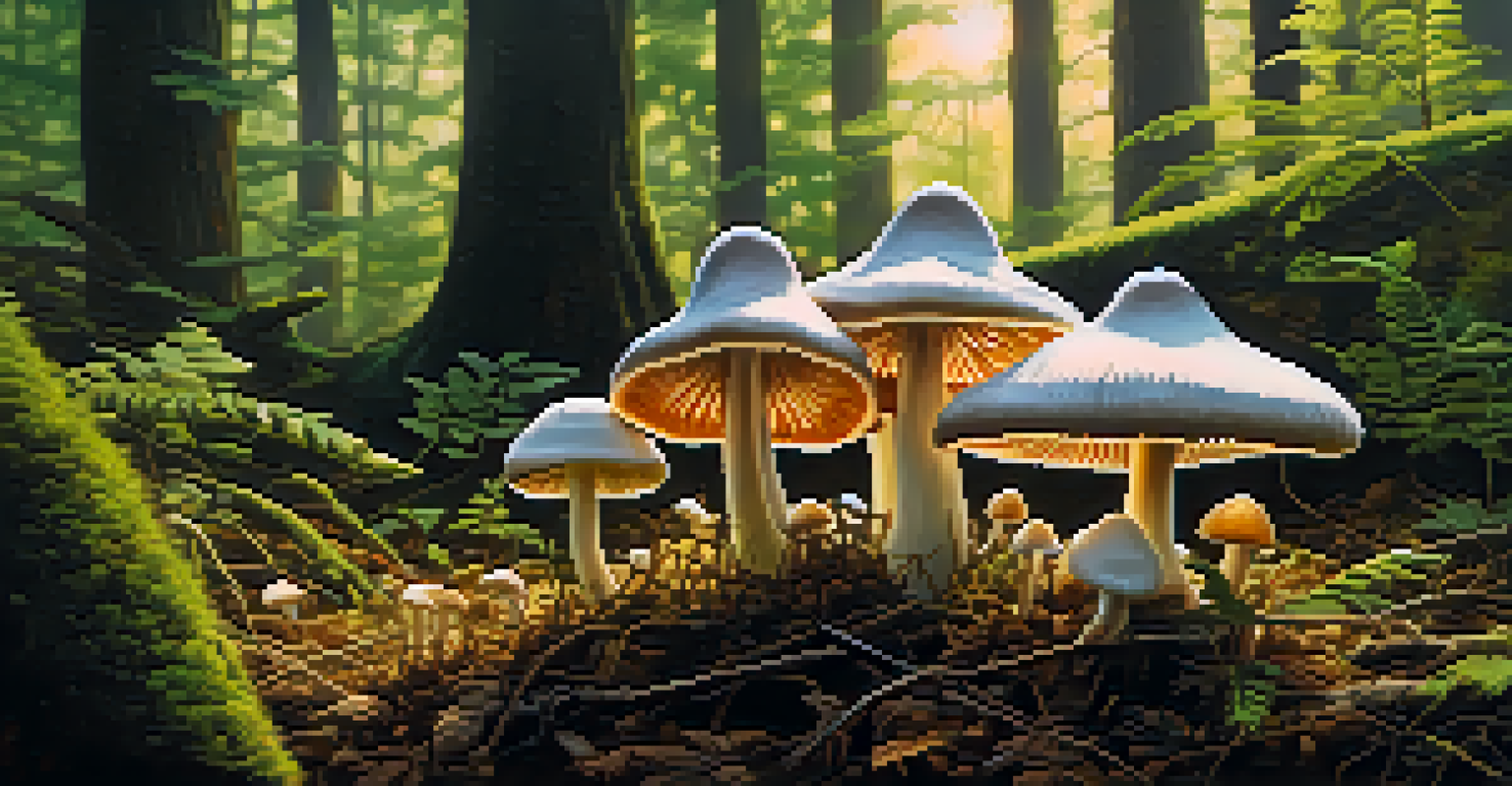Comparative Study of Peyote and Other Sacred Plants

Introduction to Sacred Plants and Their Cultural Significance
Sacred plants have been integral to various cultures for centuries, often serving as conduits for spiritual experiences. These plants, including peyote, have unique properties that facilitate deep connections between individuals and the divine. Understanding their significance involves looking at historical contexts, rituals, and the ways these plants have shaped spiritual practices.
The plant is the teacher; the ceremony is the classroom.
Peyote, specifically, is a small cactus native to the southwestern United States and Mexico, revered for its psychoactive properties. Its use dates back thousands of years among Indigenous peoples, who employ it in religious ceremonies. By comparing peyote with other sacred plants, we can appreciate the diversity of spiritual experiences they offer.
In this article, we will explore peyote alongside a variety of other sacred plants, such as ayahuasca and mushrooms, highlighting their similarities and differences. This journey will reveal the fascinating roles these plants play in spiritual and healing practices around the world.
Psychoactive Properties: A Closer Look at Peyote
Peyote contains mescaline, a powerful psychoactive compound that alters perception and consciousness. This compound is responsible for the vivid experiences and visions often reported by users during peyote ceremonies. The effects can vary widely depending on dosage, set, and setting, making each experience unique.

Traditionally, peyote is consumed in a ceremonial context, often led by a trained guide or shaman. This structured approach helps participants integrate their experiences and insights effectively. Unlike recreational drug use, the focus here is on spiritual growth and healing.
Cultural Importance of Sacred Plants
Sacred plants like peyote and ayahuasca are deeply rooted in cultural rituals and have been used for centuries to facilitate spiritual experiences.
The use of peyote has legal protections in some areas, particularly for Indigenous peoples, which distinguishes it from many other psychoactive substances. This legal status affirms its importance as a sacred plant, emphasizing the need to respect and preserve its cultural heritage.
Ayahuasca: The Amazonian Brew and Its Spiritual Journey
Ayahuasca is a potent brew made from the Banisteriopsis caapi vine and other plants, often containing DMT, another powerful psychoactive compound. Like peyote, ayahuasca has been used for centuries by Amazonian tribes for spiritual and healing purposes. The experience can lead to profound insights and emotional release, often described as a journey of self-discovery.
Nature does not hurry, yet everything is accomplished.
The ayahuasca ceremony is typically conducted by an experienced shaman who guides participants through the experience. This communal aspect fosters a sense of connection and support, enhancing the healing process. As with peyote, the importance of intention and setting plays a crucial role in shaping the experience.
While both peyote and ayahuasca are revered for their spiritual benefits, the cultural contexts and rituals surrounding their use differ significantly. Understanding these distinctions enriches our appreciation of how diverse sacred plants can be in fostering spiritual growth.
Psilocybin Mushrooms: Nature's Psychedelic Fungi
Psilocybin mushrooms, often referred to as magic mushrooms, contain the psychoactive compound psilocybin, which transforms into psilocin in the body. This transformation leads to altered perceptions, mood changes, and a deep sense of connectedness, similar to the experiences induced by peyote and ayahuasca. Many users report profound insights and emotional healing during their journeys with these mushrooms.
The use of psilocybin mushrooms has gained attention in recent years, especially within therapeutic contexts. Research indicates their potential for treating conditions like depression and anxiety, showcasing their healing properties. As with other sacred plants, the context in which they are consumed greatly influences the experience.
Unique Psychoactive Effects
Each sacred plant, such as peyote, ayahuasca, and psilocybin mushrooms, offers distinct psychoactive experiences shaped by their chemical properties and cultural contexts.
Unlike peyote and ayahuasca, psilocybin mushrooms are often accessible in various regions, leading to a more widespread use. This accessibility has sparked a growing interest in their spiritual and therapeutic potential, prompting further exploration of their role alongside other sacred plants.
Comparative Experiences: Peyote vs. Ayahuasca vs. Mushrooms
While peyote, ayahuasca, and psilocybin mushrooms all share psychoactive properties, the experiences they offer can be markedly different. Peyote is often characterized by visual and auditory hallucinations, while ayahuasca may lead to intense emotional purging and introspection. Psilocybin mushrooms can provide a more playful experience, with a focus on interconnectedness.
Each plant's effects are shaped by its unique chemical composition and the cultural practices surrounding its use. For instance, the ceremonial context of peyote may lead to a more structured and guided experience compared to the more spontaneous nature of psilocybin use. This highlights the importance of understanding the context in which these plants are consumed.
Ultimately, the choice between these sacred plants will depend on individual preferences, intentions, and desired outcomes. By exploring these differences, we can better appreciate the rich tapestry of spiritual experiences offered by each plant.
Cultural Appropriation and Ethical Considerations
As interest in sacred plants grows, so do concerns about cultural appropriation. Many Indigenous communities have used these plants for generations, and their rituals and teachings are deeply rooted in their cultural identities. It's essential to approach these practices with respect and understanding, recognizing their significance to those who have traditionally utilized them.
Engaging with sacred plants outside of their cultural context can lead to misunderstandings and a commodification of spiritual experiences. This can diminish the value of the rituals and teachings that accompany their use, ultimately displacing the communities that have preserved this knowledge for centuries.
Ethical Use and Cultural Respect
As interest in sacred plants grows, it's crucial to engage with them ethically and respectfully, recognizing their significance to Indigenous cultures.
To honor the traditions surrounding sacred plants, individuals should seek guidance from Indigenous practitioners and engage in respectful, informed discussions. This approach fosters a deeper understanding of the cultural significance of these plants and supports the communities that have long revered them.
The Future of Sacred Plants in Modern Spirituality
The renewed interest in sacred plants is reshaping modern spirituality, with many individuals seeking alternative paths to healing and self-discovery. As societies increasingly acknowledge the potential benefits of these plants, there is a growing movement advocating for their responsible and respectful use. This shift is prompting conversations around legal frameworks, accessibility, and ethical considerations.
With ongoing research into the therapeutic applications of peyote, ayahuasca, and psilocybin mushrooms, the future looks promising for these sacred plants. As more people turn to them for healing, it is vital to approach their use with a sense of reverence and responsibility. This ensures that the rich cultural heritages associated with these plants are preserved and respected.

Ultimately, the future of sacred plants lies in balancing modern exploration with traditional wisdom. By fostering a respectful dialogue between cultures, we can create a more inclusive understanding of these powerful plants and their role in spiritual practices.
Conclusion: Embracing the Wisdom of Sacred Plants
In conclusion, the comparative study of peyote and other sacred plants reveals a rich tapestry of spiritual traditions and experiences. Each plant offers unique insights and healing potential, shaped by its cultural context and the rituals surrounding its use. By exploring these differences, we gain a deeper appreciation for the wisdom embedded in these ancient practices.
As we navigate the modern landscape of spirituality, it's essential to approach sacred plants with respect and mindfulness. Engaging with these plants can provide profound insights, but it also requires a commitment to understanding their cultural significance and ethical implications.
Ultimately, the journey into the world of sacred plants invites us to connect with ourselves, others, and the greater universe. By embracing this wisdom, we can foster spiritual growth and healing while honoring the traditions that have preserved these powerful plants for generations.